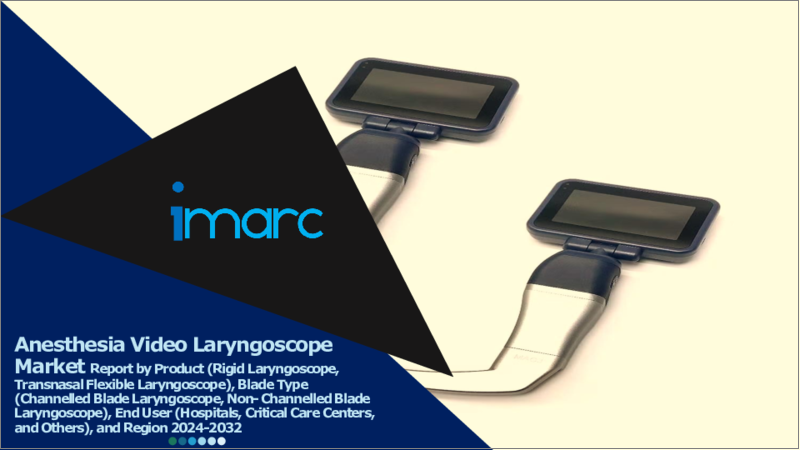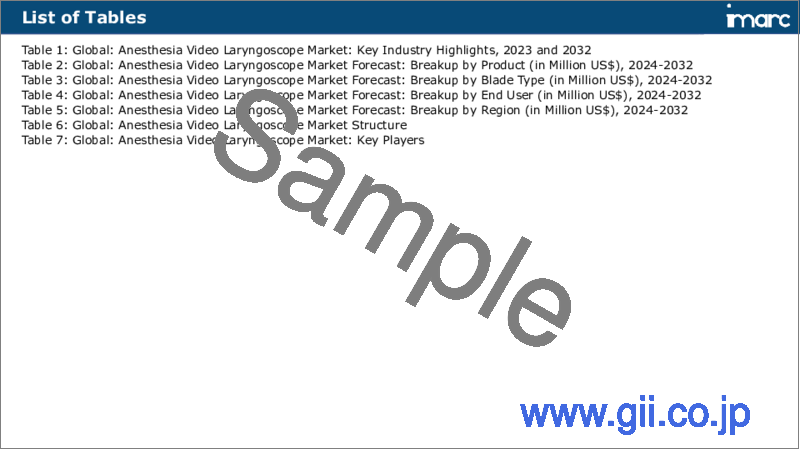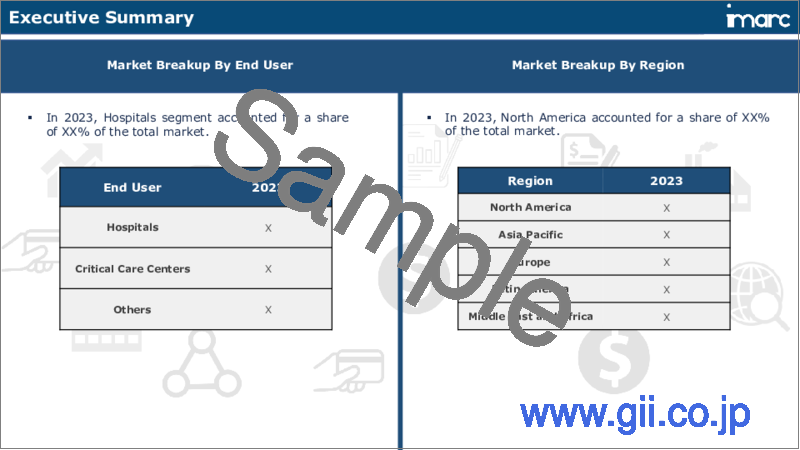|
|
市場調査レポート
商品コード
1541443
麻酔用ビデオ喉頭鏡市場レポート:製品タイプ、ブレードタイプ、エンドユーザー、地域別、2024年~2032年Anesthesia Video Laryngoscope Market Report by Product, Blade Type, End User, and Region 2024-2032 |
||||||
カスタマイズ可能
|
|||||||
| 麻酔用ビデオ喉頭鏡市場レポート:製品タイプ、ブレードタイプ、エンドユーザー、地域別、2024年~2032年 |
|
出版日: 2024年08月10日
発行: IMARC
ページ情報: 英文 150 Pages
納期: 2~3営業日
|
- 全表示
- 概要
- 図表
- 目次
麻酔用ビデオ喉頭鏡の世界市場規模は、2023年に2億170万米ドルに達しました。今後、IMARC Groupは、市場は2032年までに3億2,530万米ドルに達し、2024年から2032年の間に5.3%の成長率(CAGR)を示すと予測しています。
麻酔用ビデオ喉頭鏡は、前喉頭を隅々まで観察するための挿管装置です。ブレード、バッテリー、カメラ、付属モニターで構成され、気道構造の拡大画像を表示し、気管内挿管(ETI)を容易にします。従来の直接喉頭鏡(DL)と異なり、ビデオ喉頭鏡(VL)は、施術者が直接視線を送る必要がなく、詳細な検査を行うことができます。その結果、麻酔用ビデオ喉頭鏡は、喉頭鏡検査の複雑な症例を管理するために、救急医療や二次医療の現場で広く利用されています。また、小型で持ち運びが容易なことから、医療機関での教育用ツールとしても使用されています。
コロナウイルス感染症(COVID-19)の患者数が増加しているため、手術室以外や敷地外の環境で患者にETIを提供するための麻酔用ビデオ喉頭鏡の需要が増加しています。また、医療従事者の顔を患者の気道から遠ざけることができるため、感染のリスクを最小限に抑えることができます。これらの機器は、ビデオストリームをSDメモリーカードに保存することもできます。これとは別に、肥満の有病率の上昇とヘルスケア・インフラの改善により、麻酔用ビデオ喉頭鏡の採用が増加しています。このほか、大手企業は小児医療に役立つ製品バリエーションのイントロダクション注力しています。これは、低侵襲手術(MIS)の人気の高まりと相まって、今後数年間の市場成長を促進すると予想されます。
本レポートで扱う主な質問
- 世界の麻酔用ビデオ喉頭鏡市場はこれまでどのように推移し、今後どのように推移していくのか?
- 主要な地域市場は?
- COVID-19は世界の麻酔用ビデオ喉頭鏡市場にどのような影響を与えたか?
- 製品別の市場内訳は?
- ブレードタイプ別の市場内訳は?
- エンドユーザー別の市場内訳は?
- 業界のバリューチェーンにおける様々な段階とは?
- 業界の主要な促進要因と課題は何か?
- 世界の麻酔用ビデオ喉頭鏡市場の構造と主要プレーヤーは?
- 業界の競合の程度は?
目次
第1章 序文
第2章 調査範囲と調査手法
- 調査の目的
- ステークホルダー
- データソース
- 一次情報
- 二次情報
- 市場推定
- ボトムアップアプローチ
- トップダウンアプローチ
- 調査手法
第3章 エグゼクティブサマリー
第4章 イントロダクション
- 概要
- 主要業界動向
第5章 世界の麻酔用ビデオ喉頭鏡市場
- 市場概要
- 市場実績
- COVID-19の影響
- 市場予測
第6章 市場内訳:製品別
- 硬性喉頭鏡
- 市場動向
- 市場予測
- 経鼻軟性喉頭鏡
- 市場動向
- 市場予測
第7章 市場内訳:ブレードタイプ別
- チャネルブレード喉頭鏡
- 市場動向
- 市場予測
- 非チャネルブレード喉頭鏡
- 市場動向
- 市場予測
第8章 市場内訳:エンドユーザー別
- 病院
- 市場動向
- 市場予測
- 救命救急センター
- 市場動向
- 市場予測
- その他
- 市場動向
- 市場予測
第9章 市場内訳:地域別
- 北米
- 米国
- カナダ
- アジア太平洋地域
- 中国
- 日本
- インド
- 韓国
- オーストラリア
- インドネシア
- その他
- 欧州
- ドイツ
- フランス
- 英国
- イタリア
- スペイン
- ロシア
- その他
- ラテンアメリカ
- ブラジル
- メキシコ
- その他
- 中東・アフリカ
- 市場動向
- 市場内訳:国別
- 市場予測
第10章 SWOT分析
- 概要
- 強み
- 弱み
- 機会
- 脅威
第11章 バリューチェーン分析
第12章 ポーターのファイブフォース分析
- 概要
- 買い手の交渉力
- 供給企業の交渉力
- 競合の程度
- 新規参入業者の脅威
- 代替品の脅威
第13章 価格分析
第14章 競合情勢
- 市場構造
- 主要企業
- 主要企業のプロファイル
- Ambu A/S
- ATMOS MedizinTechnik GmbH & Co. KG
- BOMImed Inc.
- Clarus Medical LLC
- Daiken Medical Co Ltd.
- KARL STORZ SE & Co. KG
- Medtronic Plc
- Olympus Corporation
- Orlvision GmbH
- Prosurg Inc.
- Teleflex Incorporated
- Velosal Medical Incorporated
- Verathon Inc.(Roper Technologies)
- XION GmbH(Henke-Sass, Wolf GmbH)
List of Figures
- Figure 1: Global: Anesthesia Video Laryngoscope Market: Major Drivers and Challenges
- Figure 2: Global: Anesthesia Video Laryngoscope Market: Sales Value (in Million US$), 2018-2023
- Figure 3: Global: Anesthesia Video Laryngoscope Market: Breakup by Product (in %), 2023
- Figure 4: Global: Anesthesia Video Laryngoscope Market: Breakup by Blade Type (in %), 2023
- Figure 5: Global: Anesthesia Video Laryngoscope Market: Breakup by End User (in %), 2023
- Figure 6: Global: Anesthesia Video Laryngoscope Market: Breakup by Region (in %), 2023
- Figure 7: Global: Anesthesia Video Laryngoscope Market Forecast: Sales Value (in Million US$), 2024-2032
- Figure 8: Global: Anesthesia Video Laryngoscope (Rigid Laryngoscope) Market: Sales Value (in Million US$), 2018 & 2023
- Figure 9: Global: Anesthesia Video Laryngoscope (Rigid Laryngoscope) Market Forecast: Sales Value (in Million US$), 2024-2032
- Figure 10: Global: Anesthesia Video Laryngoscope (Transnasal Laryngoscope) Market: Sales Value (in Million US$), 2018 & 2023
- Figure 11: Global: Anesthesia Video Laryngoscope (Transnasal Laryngoscope) Market Forecast: Sales Value (in Million US$), 2024-2032
- Figure 12: Global: Anesthesia Video Laryngoscope (Channelled Laryngoscope) Market: Sales Value (in Million US$), 2018 & 2023
- Figure 13: Global: Anesthesia Video Laryngoscope (Channelled Laryngoscope) Market Forecast: Sales Value (in Million US$), 2024-2032
- Figure 14: Global: Anesthesia Video Laryngoscope (Non-Channelled Laryngoscope) Market: Sales Value (in Million US$), 2018 & 2023
- Figure 15: Global: Anesthesia Video Laryngoscope (Non-Channelled Laryngoscope) Market Forecast: Sales Value (in Million US$), 2024-2032
- Figure 16: Global: Anesthesia Video Laryngoscope (Hospitals) Market: Sales Value (in Million US$), 2018 & 2023
- Figure 17: Global: Anesthesia Video Laryngoscope (Hospitals) Market Forecast: Sales Value (in Million US$), 2024-2032
- Figure 18: Global: Anesthesia Video Laryngoscope (Critical Care Centers) Market: Sales Value (in Million US$), 2018 & 2023
- Figure 19: Global: Anesthesia Video Laryngoscope (Critical Care Centers) Market Forecast: Sales Value (in Million US$), 2024-2032
- Figure 20: Global: Anesthesia Video Laryngoscope (Other End Users) Market: Sales Value (in Million US$), 2018 & 2023
- Figure 21: Global: Anesthesia Video Laryngoscope (Other End Users) Market Forecast: Sales Value (in Million US$), 2024-2032
- Figure 22: North America: Anesthesia Video Laryngoscope Market: Sales Value (in Million US$), 2018 & 2023
- Figure 23: North America: Anesthesia Video Laryngoscope Market Forecast: Sales Value (in Million US$), 2024-2032
- Figure 24: United States: Anesthesia Video Laryngoscope Market: Sales Value (in Million US$), 2018 & 2023
- Figure 25: United States: Anesthesia Video Laryngoscope Market Forecast: Sales Value (in Million US$), 2024-2032
- Figure 26: Canada: Anesthesia Video Laryngoscope Market: Sales Value (in Million US$), 2018 & 2023
- Figure 27: Canada: Anesthesia Video Laryngoscope Market Forecast: Sales Value (in Million US$), 2024-2032
- Figure 28: Asia Pacific: Anesthesia Video Laryngoscope Market: Sales Value (in Million US$), 2018 & 2023
- Figure 29: Asia Pacific: Anesthesia Video Laryngoscope Market Forecast: Sales Value (in Million US$), 2024-2032
- Figure 30: China: Anesthesia Video Laryngoscope Market: Sales Value (in Million US$), 2018 & 2023
- Figure 31: China: Anesthesia Video Laryngoscope Market Forecast: Sales Value (in Million US$), 2024-2032
- Figure 32: Japan: Anesthesia Video Laryngoscope Market: Sales Value (in Million US$), 2018 & 2023
- Figure 33: Japan: Anesthesia Video Laryngoscope Market Forecast: Sales Value (in Million US$), 2024-2032
- Figure 34: India: Anesthesia Video Laryngoscope Market: Sales Value (in Million US$), 2018 & 2023
- Figure 35: India: Anesthesia Video Laryngoscope Market Forecast: Sales Value (in Million US$), 2024-2032
- Figure 36: South Korea: Anesthesia Video Laryngoscope Market: Sales Value (in Million US$), 2018 & 2023
- Figure 37: South Korea: Anesthesia Video Laryngoscope Market Forecast: Sales Value (in Million US$), 2024-2032
- Figure 38: Australia: Anesthesia Video Laryngoscope Market: Sales Value (in Million US$), 2018 & 2023
- Figure 39: Australia: Anesthesia Video Laryngoscope Market Forecast: Sales Value (in Million US$), 2024-2032
- Figure 40: Indonesia: Anesthesia Video Laryngoscope Market: Sales Value (in Million US$), 2018 & 2023
- Figure 41: Indonesia: Anesthesia Video Laryngoscope Market Forecast: Sales Value (in Million US$), 2024-2032
- Figure 42: Others: Anesthesia Video Laryngoscope Market: Sales Value (in Million US$), 2018 & 2023
- Figure 43: Others: Anesthesia Video Laryngoscope Market Forecast: Sales Value (in Million US$), 2024-2032
- Figure 44: Europe: Anesthesia Video Laryngoscope Market: Sales Value (in Million US$), 2018 & 2023
- Figure 45: Europe: Anesthesia Video Laryngoscope Market Forecast: Sales Value (in Million US$), 2024-2032
- Figure 46: Germany: Anesthesia Video Laryngoscope Market: Sales Value (in Million US$), 2018 & 2023
- Figure 47: Germany: Anesthesia Video Laryngoscope Market Forecast: Sales Value (in Million US$), 2024-2032
- Figure 48: France: Anesthesia Video Laryngoscope Market: Sales Value (in Million US$), 2018 & 2023
- Figure 49: France: Anesthesia Video Laryngoscope Market Forecast: Sales Value (in Million US$), 2024-2032
- Figure 50: United Kingdom: Anesthesia Video Laryngoscope Market: Sales Value (in Million US$), 2018 & 2023
- Figure 51: United Kingdom: Anesthesia Video Laryngoscope Market Forecast: Sales Value (in Million US$), 2024-2032
- Figure 52: Italy: Anesthesia Video Laryngoscope Market: Sales Value (in Million US$), 2018 & 2023
- Figure 53: Italy: Anesthesia Video Laryngoscope Market Forecast: Sales Value (in Million US$), 2024-2032
- Figure 54: Spain: Anesthesia Video Laryngoscope Market: Sales Value (in Million US$), 2018 & 2023
- Figure 55: Spain: Anesthesia Video Laryngoscope Market Forecast: Sales Value (in Million US$), 2024-2032
- Figure 56: Russia: Anesthesia Video Laryngoscope Market: Sales Value (in Million US$), 2018 & 2023
- Figure 57: Russia: Anesthesia Video Laryngoscope Market Forecast: Sales Value (in Million US$), 2024-2032
- Figure 58: Others: Anesthesia Video Laryngoscope Market: Sales Value (in Million US$), 2018 & 2023
- Figure 59: Others: Anesthesia Video Laryngoscope Market Forecast: Sales Value (in Million US$), 2024-2032
- Figure 60: Latin America: Anesthesia Video Laryngoscope Market: Sales Value (in Million US$), 2018 & 2023
- Figure 61: Latin America: Anesthesia Video Laryngoscope Market Forecast: Sales Value (in Million US$), 2024-2032
- Figure 62: Brazil: Anesthesia Video Laryngoscope Market: Sales Value (in Million US$), 2018 & 2023
- Figure 63: Brazil: Anesthesia Video Laryngoscope Market Forecast: Sales Value (in Million US$), 2024-2032
- Figure 64: Mexico: Anesthesia Video Laryngoscope Market: Sales Value (in Million US$), 2018 & 2023
- Figure 65: Mexico: Anesthesia Video Laryngoscope Market Forecast: Sales Value (in Million US$), 2024-2032
- Figure 66: Others: Anesthesia Video Laryngoscope Market: Sales Value (in Million US$), 2018 & 2023
- Figure 67: Others: Anesthesia Video Laryngoscope Market Forecast: Sales Value (in Million US$), 2024-2032
- Figure 68: Middle East and Africa: Anesthesia Video Laryngoscope Market: Sales Value (in Million US$), 2018 & 2023
- Figure 69: Middle East and Africa: Anesthesia Video Laryngoscope Market Forecast: Sales Value (in Million US$), 2024-2032
- Figure 70: Global: Anesthesia Video Laryngoscope Industry: SWOT Analysis
- Figure 71: Global: Anesthesia Video Laryngoscope Industry: Value Chain Analysis
- Figure 72: Global: Anesthesia Video Laryngoscope Industry: Porter's Five Forces Analysis
List of Tables
- Table 1: Global: Anesthesia Video Laryngoscope Market: Key Industry Highlights, 2023 and 2032
- Table 2: Global: Anesthesia Video Laryngoscope Market Forecast: Breakup by Product (in Million US$), 2024-2032
- Table 3: Global: Anesthesia Video Laryngoscope Market Forecast: Breakup by Blade Type (in Million US$), 2024-2032
- Table 4: Global: Anesthesia Video Laryngoscope Market Forecast: Breakup by End User (in Million US$), 2024-2032
- Table 5: Global: Anesthesia Video Laryngoscope Market Forecast: Breakup by Region (in Million US$), 2024-2032
- Table 6: Global: Anesthesia Video Laryngoscope Market Structure
- Table 7: Global: Anesthesia Video Laryngoscope Market: Key Players
The global anesthesia video laryngoscope market size reached US$ 201.7 Million in 2023. Looking forward, IMARC Group expects the market to reach US$ 325.3 Million by 2032, exhibiting a growth rate (CAGR) of 5.3% during 2024-2032.
An anesthesia video laryngoscope is an intubation device used to provide an around-the-corner view of the anterior larynx. It comprises blades, batteries, a camera and an attached monitor to display an enlarged image of the airway structure and facilitate endotracheal intubation (ETI). Unlike conventional direct laryngoscopy (DL), video laryngoscopy (VL) eliminates the requirement for a direct line of sight for practitioners and helps them carry out a detailed examination. Consequently, anesthesia video laryngoscopes are widely utilized in emergency or secondary care settings to manage complicated cases of laryngoscopy. They are also used as teaching tools in medical institutes, owing to their small size and portability.
Due to the rising cases of the coronavirus disease (COVID-19), there is a rise in the demand for anesthesia video laryngoscopes to provide ETI to patients in the nonoperating room or off-site settings. It also keeps the faces of healthcare professionals away from the airways of patients, thereby minimizing the risk of transmission. These devices can also store the video stream on SD memory cards. Apart from this, the rising prevalence of obesity, along with improvements in the healthcare infrastructure, has increased the adoption of anesthesia video laryngoscope. Besides this, the leading players are focusing on the introduction of product variants that aid in pediatric care. This, in confluence with the growing popularity of minimally invasive surgeries (MIS), is expected to impel the market growth in the coming years.
Key Market Segmentation:
IMARC Group provides an analysis of the key trends in each sub-segment of the global anesthesia video laryngoscope market report, along with forecasts at the global, regional and country level from 2024-2032. Our report has categorized the market based on product, blade type and end user.
Breakup by Product:
Rigid Laryngoscope
Transnasal Flexible Laryngoscope
Breakup by Blade Type:
Channelled Blade Laryngoscope
Non- Channelled Blade Laryngoscope
Breakup by End User:
Hospitals
Critical Care Centers
Others
Breakup by Region:
North America
United States
Canada
Asia Pacific
China
Japan
India
South Korea
Australia
Indonesia
Others
Europe
Germany
France
United Kingdom
Italy
Spain
Russia
Others
Latin America
Brazil
Mexico
Others
Middle East and Africa
Competitive Landscape:
The report has also analysed the competitive landscape of the market with some of the key players being Ambu A/S, ATMOS MedizinTechnik GmbH & Co. KG, BOMImed Inc., Clarus Medical LLC, Daiken Medical Co Ltd., KARL STORZ SE & Co. KG, Medtronic Plc, Olympus Corporation, Orlvision GmbH, Prosurg Inc., Teleflex Incorporated, Velosal Medical Incorporated, Verathon Inc. (Roper Technologies) and XION GmbH (Henke-Sass, Wolf GmbH).
Key Questions Answered in This Report:
- How has the global anesthesia video laryngoscope market performed so far and how will it perform in the coming years?
- What are the key regional markets?
- What has been the impact of COVID-19 on the global anesthesia video laryngoscope market?
- What is the breakup of the market based on the product?
- What is the breakup of the market based on the blade type?
- What is the breakup of the market based on the end user?
- What are the various stages in the value chain of the industry?
- What are the key driving factors and challenges in the industry?
- What is the structure of the global anesthesia video laryngoscope market and who are the key players?
- What is the degree of competition in the industry?
Table of Contents
1 Preface
2 Scope and Methodology
- 2.1 Objectives of the Study
- 2.2 Stakeholders
- 2.3 Data Sources
- 2.3.1 Primary Sources
- 2.3.2 Secondary Sources
- 2.4 Market Estimation
- 2.4.1 Bottom-Up Approach
- 2.4.2 Top-Down Approach
- 2.5 Forecasting Methodology
3 Executive Summary
4 Introduction
- 4.1 Overview
- 4.2 Key Industry Trends
5 Global Anesthesia Video Laryngoscope Market
- 5.1 Market Overview
- 5.2 Market Performance
- 5.3 Impact of COVID-19
- 5.4 Market Forecast
6 Market Breakup by Product
- 6.1 Rigid Laryngoscope
- 6.1.1 Market Trends
- 6.1.2 Market Forecast
- 6.2 Transnasal Flexible Laryngoscope
- 6.2.1 Market Trends
- 6.2.2 Market Forecast
7 Market Breakup by Blade Type
- 7.1 Channelled Blade Laryngoscope
- 7.1.1 Market Trends
- 7.1.2 Market Forecast
- 7.2 Non-Channelled Blade Laryngoscope
- 7.2.1 Market Trends
- 7.2.2 Market Forecast
8 Market Breakup by End User
- 8.1 Hospitals
- 8.1.1 Market Trends
- 8.1.2 Market Forecast
- 8.2 Critical Care Centers
- 8.2.1 Market Trends
- 8.2.2 Market Forecast
- 8.3 Others
- 8.3.1 Market Trends
- 8.3.2 Market Forecast
9 Market Breakup by Region
- 9.1 North America
- 9.1.1 United States
- 9.1.1.1 Market Trends
- 9.1.1.2 Market Forecast
- 9.1.2 Canada
- 9.1.2.1 Market Trends
- 9.1.2.2 Market Forecast
- 9.1.1 United States
- 9.2 Asia Pacific
- 9.2.1 China
- 9.2.1.1 Market Trends
- 9.2.1.2 Market Forecast
- 9.2.2 Japan
- 9.2.2.1 Market Trends
- 9.2.2.2 Market Forecast
- 9.2.3 India
- 9.2.3.1 Market Trends
- 9.2.3.2 Market Forecast
- 9.2.4 South Korea
- 9.2.4.1 Market Trends
- 9.2.4.2 Market Forecast
- 9.2.5 Australia
- 9.2.5.1 Market Trends
- 9.2.5.2 Market Forecast
- 9.2.6 Indonesia
- 9.2.6.1 Market Trends
- 9.2.6.2 Market Forecast
- 9.2.7 Others
- 9.2.7.1 Market Trends
- 9.2.7.2 Market Forecast
- 9.2.1 China
- 9.3 Europe
- 9.3.1 Germany
- 9.3.1.1 Market Trends
- 9.3.1.2 Market Forecast
- 9.3.2 France
- 9.3.2.1 Market Trends
- 9.3.2.2 Market Forecast
- 9.3.3 United Kingdom
- 9.3.3.1 Market Trends
- 9.3.3.2 Market Forecast
- 9.3.4 Italy
- 9.3.4.1 Market Trends
- 9.3.4.2 Market Forecast
- 9.3.5 Spain
- 9.3.5.1 Market Trends
- 9.3.5.2 Market Forecast
- 9.3.6 Russia
- 9.3.6.1 Market Trends
- 9.3.6.2 Market Forecast
- 9.3.7 Others
- 9.3.7.1 Market Trends
- 9.3.7.2 Market Forecast
- 9.3.1 Germany
- 9.4 Latin America
- 9.4.1 Brazil
- 9.4.1.1 Market Trends
- 9.4.1.2 Market Forecast
- 9.4.2 Mexico
- 9.4.2.1 Market Trends
- 9.4.2.2 Market Forecast
- 9.4.3 Others
- 9.4.3.1 Market Trends
- 9.4.3.2 Market Forecast
- 9.4.1 Brazil
- 9.5 Middle East and Africa
- 9.5.1 Market Trends
- 9.5.2 Market Breakup by Country
- 9.5.3 Market Forecast
10 SWOT Analysis
- 10.1 Overview
- 10.2 Strengths
- 10.3 Weaknesses
- 10.4 Opportunities
- 10.5 Threats
11 Value Chain Analysis
12 Porters Five Forces Analysis
- 12.1 Overview
- 12.2 Bargaining Power of Buyers
- 12.3 Bargaining Power of Suppliers
- 12.4 Degree of Competition
- 12.5 Threat of New Entrants
- 12.6 Threat of Substitutes
13 Price Analysis
14 Competitive Landscape
- 14.1 Market Structure
- 14.2 Key Players
- 14.3 Profiles of Key Players
- 14.3.1 Ambu A/S
- 14.3.1.1 Company Overview
- 14.3.1.2 Product Portfolio
- 14.3.1.3 Financials
- 14.3.1.4 SWOT Analysis
- 14.3.1 ATMOS MedizinTechnik GmbH & Co. KG
- 14.3.1.1 Company Overview
- 14.3.1.2 Product Portfolio
- 14.3.2 BOMImed Inc.
- 14.3.2.1 Company Overview
- 14.3.2.2 Product Portfolio
- 14.3.3 Clarus Medical LLC
- 14.3.3.1 Company Overview
- 14.3.3.2 Product Portfolio
- 14.3.4 Daiken Medical Co Ltd.
- 14.3.4.1 Company Overview
- 14.3.4.2 Product Portfolio
- 14.3.4.3 Financials
- 14.3.5 KARL STORZ SE & Co. KG
- 14.3.5.1 Company Overview
- 14.3.5.2 Product Portfolio
- 14.3.5.3 Financials
- 14.3.5.4 SWOT Analysis
- 14.3.6 Medtronic Plc
- 14.3.6.1 Company Overview
- 14.3.6.2 Product Portfolio
- 14.3.7 Olympus Corporation
- 14.3.7.1 Company Overview
- 14.3.7.2 Product Portfolio
- 14.3.7.3 Financials
- 14.3.7.4 SWOT Analysis
- 14.3.8 Orlvision GmbH
- 14.3.8.1 Company Overview
- 14.3.8.2 Product Portfolio
- 14.3.8.3 Financials
- 14.3.9 Prosurg Inc.
- 14.3.9.1 Company Overview
- 14.3.9.2 Product Portfolio
- 14.3.10 Teleflex Incorporated
- 14.3.10.1 Company Overview
- 14.3.10.2 Product Portfolio
- 14.3.10.3 Financials
- 14.3.10.4 SWOT Analysis
- 14.3.11 Velosal Medical Incorporated
- 14.3.11.1 Company Overview
- 14.3.11.2 Product Portfolio
- 14.3.12 Verathon Inc. (Roper Technologies)
- 14.3.12.1 Company Overview
- 14.3.12.2 Product Portfolio
- 14.3.12.3 SWOT Analysis
- 14.3.13 XION GmbH (Henke-Sass, Wolf GmbH)
- 14.3.13.1 Company Overview
- 14.3.13.2 Product Portfolio
- 14.3.13.3 Financials
- 14.3.1 Ambu A/S






